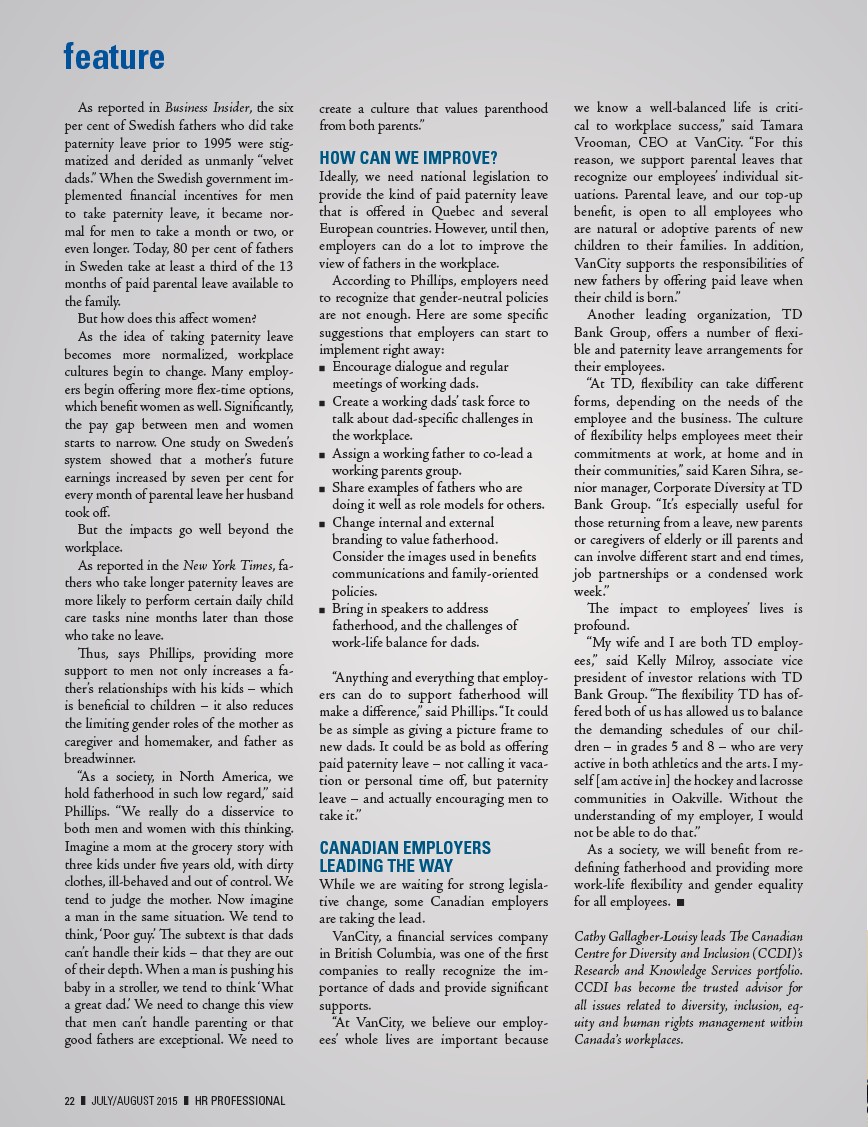
As reported in Business Insider, the six
per cent of Swedish fathers who did take
paternity leave prior to 1995 were stigmatized
and derided as unmanly “velvet
dads.” When the Swedish government implemented
financial incentives for men
to take paternity leave, it became normal
for men to take a month or two, or
even longer. Today, 80 per cent of fathers
in Sweden take at least a third of the 13
months of paid parental leave available to
the family.
But how does this affect women?
As the idea of taking paternity leave
becomes more normalized, workplace
cultures begin to change. Many employers
begin offering more flex-time options,
which benefit women as well. Significantly,
the pay gap between men and women
starts to narrow. One study on Sweden’s
system showed that a mother’s future
earnings increased by seven per cent for
every month of parental leave her husband
took off.
But the impacts go well beyond the
workplace.
As reported in the New York Times, fathers
who take longer paternity leaves are
more likely to perform certain daily child
care tasks nine months later than those
who take no leave.
Thus, says Phillips, providing more
support to men not only increases a father’s
relationships with his kids – which
is beneficial to children – it also reduces
the limiting gender roles of the mother as
caregiver and homemaker, and father as
breadwinner.
“As a society, in North America, we
hold fatherhood in such low regard,” said
Phillips. “We really do a disservice to
both men and women with this thinking.
Imagine a mom at the grocery story with
three kids under five years old, with dirty
clothes, ill-behaved and out of control. We
tend to judge the mother. Now imagine
a man in the same situation. We tend to
think, ‘Poor guy.’ The subtext is that dads
can’t handle their kids – that they are out
of their depth. When a man is pushing his
baby in a stroller, we tend to think ‘What
a great dad.’ We need to change this view
that men can’t handle parenting or that
good fathers are exceptional. We need to
create a culture that values parenthood
from both parents.”
HOW CAN WE IMPROVE?
Ideally, we need national legislation to
provide the kind of paid paternity leave
that is offered in Quebec and several
European countries. However, until then,
employers can do a lot to improve the
view of fathers in the workplace.
According to Phillips, employers need
to recognize that gender-neutral policies
are not enough. Here are some specific
suggestions that employers can start to
implement right away:
■■ Encourage dialogue and regular
meetings of working dads.
■■ Create a working dads’ task force to
talk about dad-specific challenges in
the workplace.
■■ Assign a working father to co-lead a
working parents group.
■■ Share examples of fathers who are
doing it well as role models for others.
■■ Change internal and external
branding to value fatherhood.
Consider the images used in benefits
communications and family-oriented
policies.
■■ Bring in speakers to address
fatherhood, and the challenges of
work-life balance for dads.
“Anything and everything that employers
can do to support fatherhood will
make a difference,” said Phillips. “It could
be as simple as giving a picture frame to
new dads. It could be as bold as offering
paid paternity leave – not calling it vacation
or personal time off, but paternity
leave – and actually encouraging men to
take it.”
CANADIAN EMPLOYERS
LEADING THE WAY
While we are waiting for strong legislative
change, some Canadian employers
are taking the lead.
VanCity, a financial services company
in British Columbia, was one of the first
companies to really recognize the importance
of dads and provide significant
supports.
“At VanCity, we believe our employees’
whole lives are important because
we know a well-balanced life is critical
to workplace success,” said Tamara
Vrooman, CEO at VanCity. “For this
reason, we support parental leaves that
recognize our employees’ individual situations.
Parental leave, and our top-up
benefit, is open to all employees who
are natural or adoptive parents of new
children to their families. In addition,
VanCity supports the responsibilities of
new fathers by offering paid leave when
their child is born.”
Another leading organization, TD
Bank Group, offers a number of flexible
and paternity leave arrangements for
their employees.
“At TD, flexibility can take different
forms, depending on the needs of the
employee and the business. The culture
of flexibility helps employees meet their
commitments at work, at home and in
their communities,” said Karen Sihra, senior
manager, Corporate Diversity at TD
Bank Group. “It’s especially useful for
those returning from a leave, new parents
or caregivers of elderly or ill parents and
can involve different start and end times,
job partnerships or a condensed work
week.”
The impact to employees’ lives is
profound.
“My wife and I are both TD employees,”
said Kelly Milroy, associate vice
president of investor relations with TD
Bank Group. “The flexibility TD has offered
both of us has allowed us to balance
the demanding schedules of our children
– in grades 5 and 8 – who are very
active in both athletics and the arts. I myself
am active in the hockey and lacrosse
communities in Oakville. Without the
understanding of my employer, I would
not be able to do that.”
As a society, we will benefit from redefining
fatherhood and providing more
work-life flexibility and gender equality
for all employees. n
Cathy Gallagher-Louisy leads The Canadian
Centre for Diversity and Inclusion (CCDI)’s
Research and Knowledge Services portfolio.
CCDI has become the trusted advisor for
all issues related to diversity, inclusion, equity
and human rights management within
Canada’s workplaces.
feature
22 ❚ JULY/AUGUST 2015 ❚ HR PROFESSIONAL